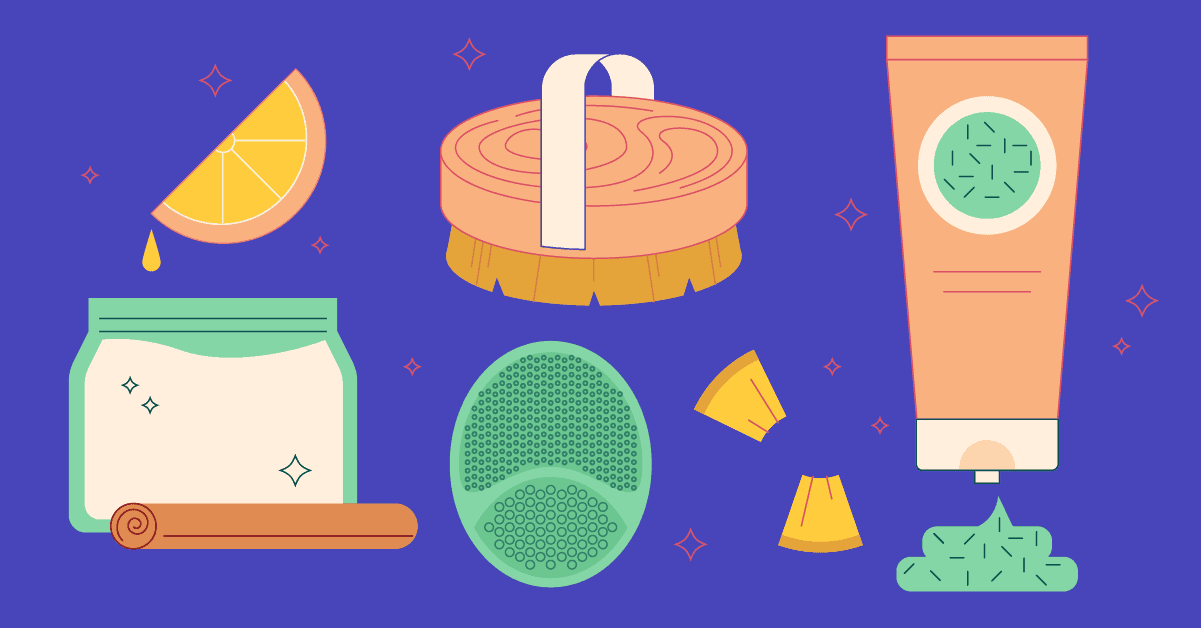Exfoliation is a word you’ll see in skincare recommendations and on product labels. But do you know what it means and how often to incorporate it into your skin routine? Exfoliation is necessary for healthy skin, but doing it too much can cause more harm than good. Read on for tips to learn how to exfoliate for clean and radiant skin.
What Does Exfoliation Do?
Dead skin cells build up from makeup, oil, and dirt, and they can leave your pores clogged and your skin dull and prone to acne. Exfoliation gained popularity about two decades ago because it sloughs off dead skin cells from the outer layer of skin and provides a smoother complexion. When done properly, exfoliation can reduce breakouts, lighten dark spots, and allow hydrating ingredients to penetrate deeper into the skin.
How Often to Exfoliate
Exfoliating too often can lead to redness, sensitivity, and even infection if you damage the outer layer of your skin. If you’re new to the process, start by exfoliating your face once a week to see how your skin reacts. If your skin reacts well, most people can exfoliate two to three times a week to prevent buildup. But if you have dry or sensitive skin, you may want to exfoliate weekly to avoid irritating your skin. The same rules apply for the body, but make sure to use separate tools or scrubs as those meant for the body can be too harsh for delicate facial skin.
Types of Exfoliants
Exfoliants come in two types: physical and chemical. Physical exfoliants include brushes, cloths, or cleansers with abrasives to physically scrub away dead skin cells. Chemical exfoliants include fruit enzymes or facial acids to loosen and wash away buildup. Chemical exfoliants work great for most skin types and they include several beneficial ingredients. Physical exfoliators can be a good alternative for sensitive skin that reacts to acids. They make it easy to tailor a gentler experience, and you can combine them with your preferred cleanser. Consider these common exfoliants.
Silicone scrubber
Use the rounded tips of a manual or electric silicone scrubber to help remove dirt from the skin’s surface. A battery-operated scrubber can be more effective in drawing out impurities with high-speed vibrations. Silicone scrubbers are gentle enough for sensitive skin on the face and body, and also hypoallergenic and anti-bacterial.
Best for: sensitive skin, deep cleaning
Dry brush
For this popular, ancient healing practice, you use a brush with stiff bristles to brush your dry skin. It can aggravate some skin issues such as eczema or psoriasis, so you should not use it on sensitive skin. While the body can stand up to a firm brush, use a softer brush on the face.
Best for: oily, thicker skin
Washcloth
Use a soft washcloth to apply a mild chemical exfoliator as a gentle way to exfoliate sensitive skin. The fibers may be too rough for your face so do it only once a week, or use it strictly for the body if your facial skin feels irritated.
Best for: body, use with chemical exfoliants
Loofah
Use the tough fibers in loofahs to exfoliate rough patches on your elbows, knees, and heels. Keep your loofah clean and replace it often because it can harbor bacteria hanging in the shower.
Best for: rough skin

Commercial scrub
Use a cleanser with small abrasives such as jojoba beads or sugar crystals to gently remove the top layer of skin. Massage gently in the shower and alternate with a regular body cleanser.
Best for: body, oily skin
DIY scrub
Sugar is one of the best natural exfoliators. Combine it with an oil, such as coconut or olive, and add optional scents such as ground cinnamon or lemon juice for a DIY body scrub.
Best for: body, sensitive skin
Fruit enzyme
Some exfoliators contain papaya, pineapple, and pumpkin enzymes to dissolve the top layer of dead skin cells. You can use them as alternatives to acids if you have sensitive skin.
Best for: acne-prone, sensitive skin, darker skin tones
Facial acid
Acid treatments, whether in serum or mask form, improve skin cell turnover to reveal smoother skin. Beta hydroxy acids and alpha-hydroxy acids (BHAs and AHAs) brighten skin, reduce bacteria, and exfoliate. Other acids to look for include glycolic, lactic, and salicylic acids. You can find most acids in over-the-counter products in low concentrations. Dermatologists can apply higher concentrations in the form of a chemical peel.
Best for: acne-prone skin, anti-aging benefits
Exfoliation Tips
Some products in your daily skincare routine may already include exfoliants or ingredients that can cause your skin to be more sensitive, including retinol or benzoyl peroxide. Check the products in your medicine cabinet for these ingredients before adding another product as excessive exfoliation can worsen skin issues.
When using a chemical exfoliator, apply with gentle circular motions, then rinse off with lukewarm water. For physical exfoliators, brush with light strokes and make sure the pressure doesn’t hurt. Avoid both types of exfoliation if you have any open wounds or a sunburn. Follow with a moisturizer to add hydration back into your skin.
Exfoliation can effectively lighten hyperpigmentation, or dark spots, by shedding these dark cells, but aggressive exfoliation can worsen spots. People with darker skin tones should avoid aggressive methods and stick with gentle scrubs or chemical exfoliants.
Conclusion
Exfoliation produces smoother, glowing skin. With a variety of options in physical and chemical exfoliators, people with most skin types can find one that’s beneficial without causing adverse effects.
